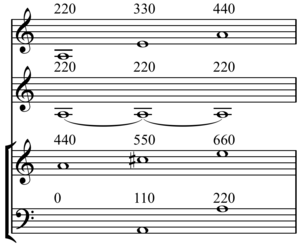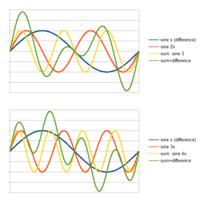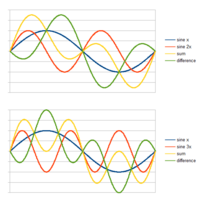
Back Kombinationston German Son résultant French Terzo suono di Tartini Italian 差音 Japanese Verschiltoon Dutch Kombinasjonstone NN Комбинационный тон Russian Kombinationston Swedish เสียงทุ้มแหลมผสม Thai Комбінаційний тон Ukrainian


A combination tone (also called resultant or subjective tone)[2] is a psychoacoustic phenomenon of an additional tone or tones that are artificially perceived when two real tones are sounded at the same time. Their discovery is credited to the violinist Giuseppe Tartini[3] and so they are also called Tartini tones.
There are two types of combination tones: sum tones whose frequencies are found by adding the frequencies of the real tones, and difference tones whose frequencies are the difference between the frequencies of the real tones. "Combination tones are heard when two pure tones (i.e., tones produced by simple harmonic sound waves having no overtones), differing in frequency by about 50 cycles per second [Hertz] or more, sound together at sufficient intensity."[2]
Combination tones can also be produced electronically by combining two signals in a circuit that has nonlinear distortion, such as an amplifier subject to clipping or a ring modulator.
- ^ Benade, Arthur H. (2014). Horns, Strings, and Harmony, p.83. Courier, Dover Books on Music. ISBN 9780486173597.
- ^ a b "Combination Tone", Britannica.com. Accessed September 2015.
- ^ "Tartini, Giuseppe". Enciclopedia Italiana. Retrieved 1 April 2021.
© MMXXIII Rich X Search. We shall prevail. All rights reserved. Rich X Search

